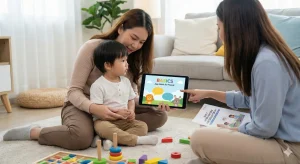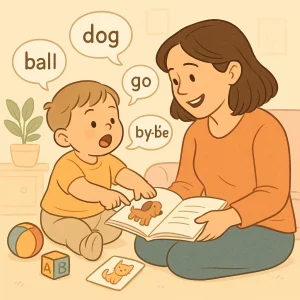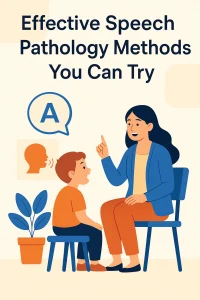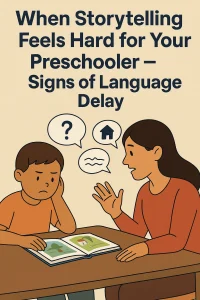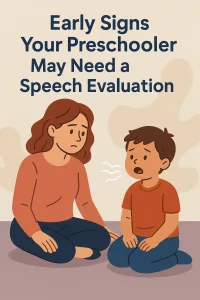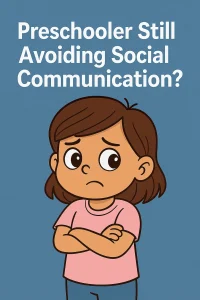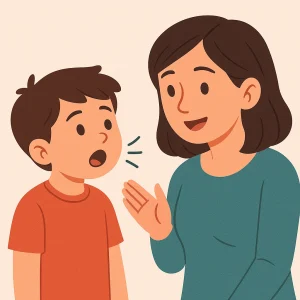Help Kids Master the “TH” Sound: Fun & Easy Tips
By Rajini D
Last Updated: March 18, 2024
Navigating the world of speech sounds can be a delightful journey for both you and your child, filled with milestones and moments of joy. Yet, one particular sound often poses a playful challenge along this path: the ‘TH’ sound. Common in everyday language, mastering this sound is a crucial step for your little one, enhancing their communication skills and boosting confidence in their speech abilities.
Why does the ‘TH’ sound stand out in the vast sea of phonetics? Unlike many other sounds, ‘TH’ requires a specific tongue and teeth placement, making it a unique endeavor for young learners. For some children, this sound comes naturally, seamlessly blending into their growing vocabulary. However, for others, it can be a tricky hurdle, needing a bit of extra practice and attention.
This is where the beauty of early practice shines brightest. Engaging in playful, supportive exercises at home can transform this learning experience from a challenge into an adventure. As parents and caregivers, your role is pivotal in guiding your child through this journey. With patience, encouragement, and a sprinkle of fun, you’ll be amazed at how swiftly progress unfolds.
Our guide on Speech and Language Milestones offers insights into what to expect at different ages.
Understanding the ‘TH’ Sound
Voiced vs. Voiceless ‘TH’ Sounds
Voiced ‘TH’ Sound: This version vibrates, humming with life, thanks to the vocal cords’ involvement. Words like “this,” “that,” and “the” are perfect examples. To feel this vibration, place a hand gently on your throat as you say these words. The buzzing sensation under your fingertips? That’s your vocal cords hard at work.
Voiceless ‘TH’ Sound: In contrast, the voiceless ‘TH’ sounds like a gentle breeze passing through, found in words such as “think,” “bath,” and “thought.” When pronouncing these, the vocal cords take a break, allowing the air to flow freely. The key difference here is in the use of your voice – or rather, the absence of it.
The Tongue and Teeth Tango
Both types of ‘TH’ sound share a unique dance between the tongue and teeth. Encourage your child to become familiar with this movement:
- For both sounds, the tip of the tongue should peek out between the front teeth, not too far, just enough to let the air pass by.
- Then, blow air gently across the tongue for the voiceless ‘TH’, and add a vocal hum for the voiced ‘TH’.
Read more: Oral Motor Exercises: Tongue Exercises for Confident Speech
Why the ‘TH’ Can Be Tricky
You might wonder, “Why does my child find the ‘TH’ sound so challenging?” Several factors can contribute to this common obstacle:
- Natural Speech Development Variance: Just as every child learns to walk at their own pace, speech sounds, including the ‘TH’, develop uniquely for every child. Some might grasp it quickly, while others take their time.
- Ear Infections: Surprisingly, frequent ear infections can impact how children hear and thus replicate sounds, including the nuanced ‘TH.’
Despite these hurdles, the good news is that with patience, practice, and the right techniques, most children can overcome difficulties with the ‘TH’ sound. It’s a journey of small, manageable steps, and every effort you make is a stride toward clear, confident communication.
Why Some Children Struggle
Common Hurdles in ‘TH’ Sound Pronunciation
Natural Speech Development Variance: Just like learning to walk or read, children develop speech at their own pace. While some sounds come easily, others, like the ‘TH’ sound, require a bit more practice. This variance is perfectly normal and part of the rich tapestry of learning and growth.
Ear Infections: Did you know that frequent ear infections can influence speech development? These infections can temporarily affect hearing, which, in turn, may impact the ability to pick up and reproduce sounds accurately, including the nuanced ‘TH’ sound.
Age Guide for ‘TH’ Sound Development
| Age Range | Expected Milestone | Tips for Support |
|---|---|---|
| Ages 3-4 | Introduction to ‘TH’ | – Engage in listening games that emphasize ‘TH’ sounds in words. – Read stories or watch shows with characters who use ‘TH’ sound words frequently to familiarize them with the sound. |
| Ages 4-5 | Improvement in pronunciation | – Practice with a mirror to help them see how the ‘TH’ sound is made, emphasizing tongue and teeth placement. – Play pronunciation matching games where they match words with their correct sounds. |
| Ages 5-7 | Mastery of ‘TH’ | – Continue practice in daily conversations, encouraging them to use ‘TH’ sound words more frequently. – Introduce fun challenges or rewards for correctly using ‘TH’ sounds in sentences. |
The Path to Improvement
While these challenges might seem daunting at first glance, they are stepping stones on the path to clear and confident communication. The key lies in early recognition and playful, supportive practice. Here’s the heartening news: with the right techniques and a dash of patience, improvement is not just possible; it’s probable.
At Wellness Hub, we believe that every child has the potential to overcome these hurdles. Our dedicated team is committed to providing parents and caregivers with the tools and strategies needed to support their little ones. Whether it’s through engaging activities that make learning fun or personalized advice to tackle unique challenges, we’re here every step of the way.
Easy Techniques to Practice at Home
Starting Simple
Model the Sound: The journey to mastering the ‘TH’ sound begins with you. By clearly demonstrating how to make the sound, you become your child’s first and most important guide. Show them how to place their tongue between their teeth and encourage them to mimic your actions. This not only teaches them the correct technique but also strengthens your bond through learning together.
Use a Mirror: A mirror can be a powerful tool in speech practice. Have your child stand in front of a mirror as they practice the ‘TH’ sound. This allows them to visually see the position of their tongue and teeth, making adjustments in real-time. It’s a simple yet effective way to ensure they’re getting the hang of it.
Also read: Speech Therapy at Home: Top Tips For Parents
Making Learning Fun
Games and Activities: Who says practice can’t be playful? Incorporate the ‘TH’ sound into fun games and activities. For instance, blowing bubbles while emphasizing the ‘TH’ sound can be a delightful way to practice. Or, engage in tongue twisters that challenge and entertain simultaneously. “Thirty-three thirsty, thundering thoroughbreds thumped Mr. Thurber on Thursday.” Try saying that three times fast!
Daily Conversations: The key to mastering any new skill is consistency. Encourage the use of ‘TH’ sound words in everyday conversations. Whether it’s during mealtime, playtime, or bedtime stories, integrating these words into daily life helps reinforce their learning. Plus, it makes practice feel like just another part of the day rather than a chore.
Interactive ‘TH’ Sound Activities for Everyday Learning
| Activity Type | Description | How to Implement |
|---|---|---|
| Mirror Practice | Watching mouth and tongue movement in a mirror. | Have your child say ‘TH’ words in front of a mirror, focusing on tongue placement between the teeth. |
| Sound Imitation Games | Mimicking the ‘TH’ sound in a playful setting. | Play a game where you say a ‘TH’ word and have your child repeat it back. Add points for correct pronunciation. |
| Storytime Focus | Reading books that feature ‘TH’ sounds prominently. | Choose books with lots of ‘TH’ sounds and emphasize these words as you read. Discuss the story and ask questions using ‘TH’ words. |
| ‘TH’ Sound Scavenger Hunt | Finding objects that start with or contain the ‘TH’ sound. | Create a list of ‘TH’ objects around the house or outside. Have a scavenger hunt to find them, encouraging your child to say the word when they find an object. |
| Crafts and Artwork | Incorporating ‘TH’ sounds into creative activities. | Engage in a craft activity where each step involves a ‘TH’ word (e.g., “thread the yarn”, “thatch the roof on a paper house”). |
| Daily Conversation Challenges | Encouraging the use of ‘TH’ sounds in everyday conversations. | Set daily challenges for your child to use a new ‘TH’ word in a sentence correctly. Offer small rewards or praise for accomplishing these challenges. |
Speech Therapy and Professional Guidance
Speech therapy isn’t just about practice; it’s about practicing the right way. A speech-language pathologist can offer targeted exercises tailored specifically to your child’s needs, making the learning process more efficient and effective. These professionals bring a wealth of experience in overcoming speech hurdles, employing techniques that are both engaging and beneficial.
At Wellness Hub, our specialists are dedicated to creating a supportive, encouraging environment. We believe that every child has the potential to communicate with confidence, and our role is to unlock this potential through compassionate, expert care.
Keeping Motivation High
The journey to clear speech is a marathon, not a sprint, and maintaining motivation is key. Here are a few tips to keep spirits high and ensure that practice feels rewarding:
- Celebrate Small Victories: Every correctly pronounced ‘TH’ sound is a step in the right direction. Celebrate these moments with your child, reinforcing their progress and boosting their confidence.
- Incorporate Practice into Favorite Activities: Whether it’s reading a book together or playing a game, integrating ‘TH’ sound practice into activities your child already loves can make learning feel like play.
- Patience and Consistency: It’s important to remember that progress in speech development can vary greatly from one child to another. Patience and consistent practice are your best allies in this journey. Reassure your child (and yourself) that with time, improvement is inevitable.
Conclusion
As we conclude our exploration of mastering the ‘TH’ sound, it’s evident that this journey is not just about overcoming a speech obstacle; it’s an opportunity for engagement and connection. Each technique, from mirroring sounds to integrating fun games, is a step toward clearer communication. Embrace these moments, knowing that with patience and consistent practice, progress is inevitable.
If you’re seeking further guidance or your child needs additional support, Wellness Hub is here to assist. Our approach is tailored to each child’s unique needs, ensuring a nurturing and effective path to speech development. Reach out to us for expert advice and resources designed to empower you and your child on this transformative journey.
Frequently Asked Questions:
1. Why is the “TH” sound difficult for children to pronounce?
The “TH” sound requires precise coordination between the tongue and teeth, a skill that may not be as instinctive for young children. This sound is unique because it involves placing the tongue slightly through the teeth and managing airflow, which can be tricky compared to more straightforward vocal or lip-based sounds.
2. At what age should children be able to pronounce the “TH” sound correctly?
Children typically begin mastering the “TH” sound around 4 to 7 years of age. This range is broad because speech development varies greatly among children. If a child hasn’t mastered the “TH” sound by 7 or shows significant struggle, it may be beneficial to seek advice from a speech-language pathologist.
3. How can I help my child practice the “TH” sound at home?
Start by modeling the sound yourself and encourage your child to mirror you. Use a mirror so they can see their tongue’s placement. Engage in activities that incorporate the “TH” sound, like reading books with ‘TH’ words or playing games that involve saying ‘TH’ words. The key is consistent, fun practice.
4. What are some fun activities for practicing the “TH” sound?
Fun activities include blowing bubbles while emphasizing the ‘TH’ sound, playing with tongue twisters that feature ‘TH’ words, and including ‘TH’ sound words in everyday conversation. These activities can transform practice into an enjoyable part of your child’s daily routine.
5. Should I be concerned if my child is struggling with the “TH” sound?
It’s common for children to face challenges with the ‘TH’ sound, but if your child is significantly struggling or their difficulty persists beyond the typical age range, consulting with a speech-language pathologist can be beneficial. They can provide reassurance, assess if there are underlying issues, and offer specific strategies for improvement.
6. How can speech therapy help with pronouncing the “TH” sound?
Speech therapy can be incredibly effective for children struggling with the ‘TH’ sound. A speech-language pathologist can offer personalized exercises that focus on tongue placement, airflow management, and making the sound in various word positions. They can also help identify any underlying issues contributing to the difficulty and suggest a tailored approach for overcoming them.
7. Can Wellness Hub help with my child’s “TH” sound pronunciation?
Absolutely! Wellness Hub specializes in child-friendly approaches to speech challenges, including difficulties with the ‘TH’ sound. Our experts provide personalized support and strategies designed to enhance your child’s speech clarity and confidence, making learning both effective and enjoyable.
8. What signs should I look out for indicating my child might need extra help with the ‘TH’ sound?
If your child consistently replaces the ‘TH’ sound with other sounds, such as ‘f’ or ‘d’ (saying “fank” instead of “thank” or “dat” instead of “that”), it may be a sign they need extra help. Difficulty sticking their tongue out between their teeth or showing frustration when attempting to pronounce ‘TH’ words are also indicators.
9. How long does it typically take for a child to improve their ‘TH’ sound pronunciation with practice?
Improvement timelines can vary widely depending on the child’s age, consistency of practice, and whether speech therapy is involved. Many children show noticeable improvement within a few weeks to several months of regular, playful practice at home. However, every child’s journey is unique.
10. Are there any specific books or resources you recommend for practicing the ‘TH’ sound?
Yes, books filled with ‘TH’ sound words can be very helpful. Titles such as “Theo’s Mood” by Maryann Cocca-Leffler or “Another Brother” by Matthew Cordell can make practice engaging. Additionally, websites like Wellness Hub offer resources and tips for integrating ‘TH’ sound practice into daily activities, making learning more accessible and fun.
About the Author:
Rajini Darugupally
M.Sc., Speech-Language Pathologist (9+ years of experience)
Rajini is a passionate and dedicated Speech-Language Pathologist with over 9+ years of experience, specializing in both developmental speech and language disorders in children and rehabilitation in adults. Driven by a desire to empower each individual to find their voice, Rajini brings a wealth of experience and a warm, genuine approach to therapy.
Currently, at Wellness Hub, she thrives in a team environment that values innovation, compassion, and achieving results for their clients.
Connect with Rajini to learn more about how she can help you or your loved one find their voice.
Book your Free Consultation Today
Parent/Caregiver Info:
Client’s Details:
* Error Message
